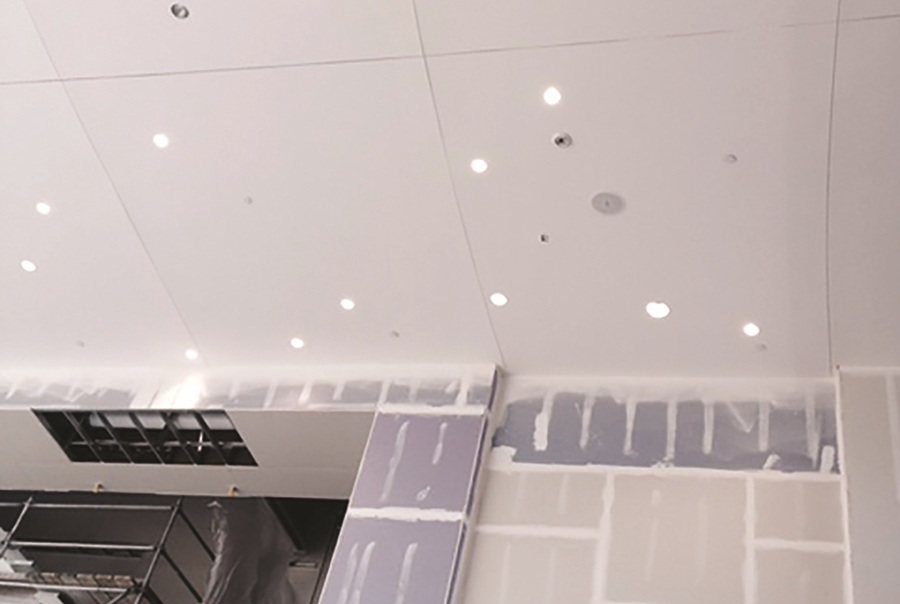Expansion is a concern on every project with large drywall runs. Expansion occurs for a variety of reasons, including humidity, temperature changes and building movement. Without the proper expansion product, cracking or drywall buckling can occur.
While Baker Triangle was building the Southwest Energy office building in Houston, they knew they would need expansion products due to the large building size and layout. In the Southwest Energy building, expansion joints were placed in the massive ceiling expanses. To accommodate the building design, Baker Triangle wanted to installed curved 093 expansion beads. In the past, the only option for curved expansion products were special order and especially expensive metal products. Facing a tight deadline, instead of waiting weeks for clunky metal 093 beads to arrive, Baker Triangle turned to Trim-Tex 093V Expansion. Trim-Tex 093V is manufactured from flexible vinyl and easily formed to match the curved ceiling reveal design in the Southwest Energy office building.

In addition to being flexible, Trim-Tex 093V features a full 3/8” in controlled movement, which is more than any other 093 product on the market. Once it is installed, architects and builders need not worry about expansion issues marring a beautiful structure. 093V also has tear off strips, allowing the the center expansion channel to remain mud free and the tear off helps create an overall sharper finished edge. Trim-Tex 093V is also designed to provide expansion control on either walls or ceilings, so regardless of the surface it can be protected from expansion problems. Like all Trim-Tex products, 093V never dents, rusts or acts as a source for mold growth, which reduces long-term building maintenance costs.
For more information, visit www.Trim-Tex.com
Related Stories
| Apr 17, 2012
Princeton Review releases “Guide to 322 Green Colleges”
The guide profiles 322 institutions of higher education in the U.S. and Canada that demonstrate notable commitments to sustainability in their academic offerings, campus infrastructure, activities and career preparation.
| Apr 17, 2012
FMI report examines federal construction trends
Given the rapid transformations occurring in the federal construction sector, FMI examines the key forces accelerating these changes, as well as their effect on the industry.
| Apr 17, 2012
Alberici receives 2012 ASA General Contractor of the Year award
Alberici has been honored by the ASA eight times in the award’s nineteen-year history--more than any other general contractor in its class.
| Apr 16, 2012
Freeland promoted to vice president at Heery International
Recently named to Building Design+Construction’s 40 Under 40 Class of 2012.
| Apr 16, 2012
University of Michigan study seeks to create efficient building design
The result, the researchers say, could be technologies capable of cutting the carbon footprint created by the huge power demands buildings place on the nation’s electrical grid.
| Apr 16, 2012
UNT lab designed to study green energy technologies completed
Lab to test energy technologies and systems in order to achieve a net-zero consumption of energy.
| Apr 16, 2012
$80 million in export financing for solar project in India
The project, “Rajasthan Sun Technique Energy Private Limited,” is a subsidiary of Reliance Power and is being co-financed by the Asian Development Bank and FMO, the Dutch development bank.
| Apr 13, 2012
Goettsch Partners designs new music building for Northwestern
The showcase facility is the recital hall, an intimate, two-level space with undulating walls of wood that provide optimal acoustics and lead to the stage, as well as a 50-foot-high wall of cable-supported, double-skin glass
| Apr 12, 2012
Solar PV carport, electrical charging stations unveiled in California
Project contractor Oltman Construction noted that the carport provides shaded area for 940 car stalls and generates 2 MW DC of electric power.
| Apr 10, 2012
JE Dunn completes two medical office buildings at St. Anthony’s Lakewood, Colo. campus
Designed by Davis Partnership Architects, P.C., Medical Plaza 1 and 2 are four-story structures totaling 96,804-sf and 101,581-sf respectively.















